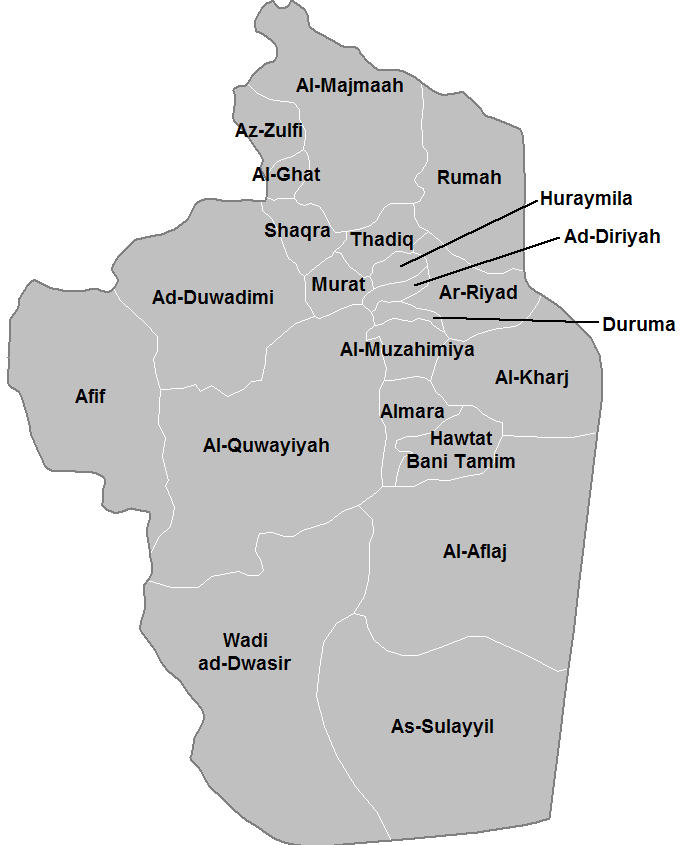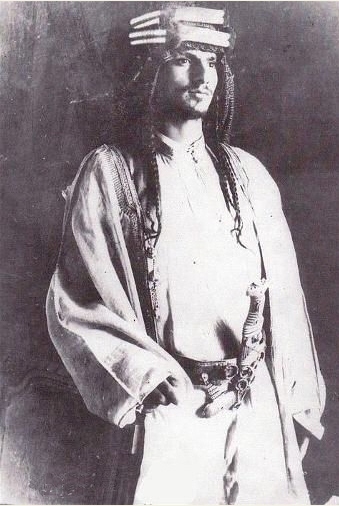|
Arwa (village)
Arwa or Arawah ( ar, عروى, ''`Arwa'') is a village in Riyadh Province, Saudi Arabia. It is located in the Dawadmi Governorate, north of the Riyadh-Makkah highway, and around west of Riyadh. The village was established in 1918 (1336 AH) at the site of a water source of the same name, by sheikh Sultan bin Mohammed Bin Hindi Bin Humaid Alotaibi. Its population is mostly from the Utaiba tribe. Several sites around Arwa contain ancient petroglyphs from different historic eras. Some carvings may date back to 1000 years BC. Arwa was the site of the Battle of Arwa in 1883 (1300 AH), where the Rashidis The Rasheed dynasty, also called Al Rasheed or the House of Rasheed ( ar, آل رشيد ; ), was a historic Arabian House or dynasty that existed in the Arabian Peninsula between 1836 and 1921. Its members were rulers of the Emirate of Ha'il an ... led by Muhammed bin Abdullah Al Rashid defeated the Utaiba and their Al Saud allies. References Populated places in Riyad ... [...More Info...] [...Related Items...] OR: [Wikipedia] [Google] [Baidu] |
Countries Of The World
The following is a list providing an overview of sovereign states around the world with information on their status and recognition of their sovereignty. The 206 listed states can be divided into three categories based on membership within the United Nations System: 193 UN member states, 2 UN General Assembly non-member observer states, and 11 other states. The ''sovereignty dispute'' column indicates states having undisputed sovereignty (188 states, of which there are 187 UN member states and 1 UN General Assembly non-member observer state), states having disputed sovereignty (16 states, of which there are 6 UN member states, 1 UN General Assembly non-member observer state, and 9 de facto states), and states having a special political status (2 states, both in free association with New Zealand). Compiling a list such as this can be a complicated and controversial process, as there is no definition that is binding on all the members of the community of nations conc ... [...More Info...] [...Related Items...] OR: [Wikipedia] [Google] [Baidu] |
Saudi Arabia
Saudi Arabia, officially the Kingdom of Saudi Arabia (KSA), is a country in Western Asia. It covers the bulk of the Arabian Peninsula, and has a land area of about , making it the List of Asian countries by area, fifth-largest country in Asia, the second-largest in the Arab world, and the largest in Western Asia and the Middle East. It is bordered by the Red Sea to the west; Jordan, Iraq, and Kuwait to the north; the Persian Gulf, Qatar and the United Arab Emirates to the east; Oman to the southeast; and Yemen to the south. Bahrain is an island country off the east coast. The Gulf of Aqaba in the northwest separates Saudi Arabia from Egypt. Saudi Arabia is the only country with a coastline along both the Red Sea and the Persian Gulf, and most of its terrain consists of arid desert, lowland, steppe, and mountains. Its capital and List of cities and towns in Saudi Arabia, largest city is Riyadh. The country is home to Mecca and Medina, the two Holiest sites in Islam, holiest citi ... [...More Info...] [...Related Items...] OR: [Wikipedia] [Google] [Baidu] |
Regions Of Saudi Arabia
The Provinces of Saudi Arabia, also known as Regions, and officially the Emirates of the Provinces of the Kingdom of Saudi Arabia (), are the 13 first-level administrative divisions of the Kingdom of Saudi Arabia. History After the unification of Saudi Arabia, the kingdom was divided into seven administrative-territorial entities: the ' Asir Province, Al Hasa' Province, the Hejaz Province, the Najd Province, the Rub' al-Khali Province and the Shammar Province. King Fahd bin Abdulaziz Al Saud issued Royal Order A/92 on March 2, 1992, known as the Regions' System, which provided for the division of the kingdom into 13 emirates. Subsequently, the five previous provinces were divided into thirteen geographic regions, called provinces (''manātiq'') and administrative regions, called the emirates of the provinces (''imārāt al-manātiq''). The emirates form the first-level administrative division of the Organization of the Kingdom of Saudi Arabia and are further divided into ... [...More Info...] [...Related Items...] OR: [Wikipedia] [Google] [Baidu] |
Riyadh Province
The Riyadh Province ( ar, منطقة الرياض '), also known as the Riyadh Region, is a region of Saudi Arabia, located in the geographic center of the country. It has an area of and with a 2017 population of 8,216,284, it is the second-largest region by both area and population, behind the Eastern Province and Mecca Region respectively. The capital governorate of the province is the Riyadh Governorate and it is named after the capital of the kingdom, Riyadh, which is the most populous city in the region and the kingdom, with a little less than two-thirds of the population of the region residing within the city. The province was governed for nearly five decades by Prince Salman bin Abdulaziz from 1963 to 2011. Other populous cities in the region include Al Ghat, Zulfi and Majma'ah. Approximately half of the region's area is desert, and it only borders other regions of the kingdom; it has no international borders. The region borders, clockwise from the north, the East ... [...More Info...] [...Related Items...] OR: [Wikipedia] [Google] [Baidu] |
Arabia Standard Time
UTC+03:00 is an identifier for a time offset from UTC of +03:00. In areas using this time offset, the time is three hours later than the Coordinated Universal Time (UTC). Following the ISO 8601 standard, a time with this offset would be written as, for example, 2019-02-08T23:36:06+03:00. As standard time (year-round) :''Principal cities: Moscow, Saint Petersburg, Doha, Riyadh, Baghdad, Nairobi, Dire Dawa, Addis Ababa, Manama, Sana'a, Aden, Minsk, Kuwait City, Asmara, Antananarivo, Kampala, Amman, Damascus'' Africa East Africa *Comoros *Djibouti *Eritrea *Ethiopia *France **French Southern and Antarctic Lands *** Scattered Islands in the Indian Ocean **** Bassas da India, Europa Island and Juan de Nova Island **Mayotte *Kenya *Madagascar *Somalia *Somaliland ''(disputed territory)'' *South Africa ** Prince Edward Islands *Tanzania *Uganda Antarctica *Some bases in Antarctica. See also Time in Antarctica **Japan *** Showa Station Asia Arabia Standard Time Arab ... [...More Info...] [...Related Items...] OR: [Wikipedia] [Google] [Baidu] |
Dawadmi
Dawadmi or Ad Dawadimi ( ar, الدوادمي) is a town in Riyadh Province, Saudi Arabia. Google Maps spells the name as Al Duwadimi. As of the 2004 census it had a population of 53,071 people. The town is mostly inhabited by the tribe of Banu 'Utaybah. It is located on top of Najd hill, the central area of Saudi Arabia. It is about west of Riyadh. " '' CNN''. January 10, 2013. Retrieved on January 10, 2013. By road, is located by road west of Riyadh. In April 2003, the new airport in the city was inaugurated by th ... [...More Info...] [...Related Items...] OR: [Wikipedia] [Google] [Baidu] |
Utaiba
The Otaibah (, also spelled Otaiba, Utaybah) is one of the biggest Arab tribes originating in the Arabian Peninsula. Their distribution spans throughout Saudi Arabia, especially in Najd. and the Middle East. The Otaibah are descended from the Bedouin. They trace back to the Mudar family and belong to the Qays ʿAylān confederacy through its previous name, Hawazin. Research of the lineage of northern tribes may began with Adnan (instead of Ishmael), as passed on by oral tradition. He is the common ancestor of the modern Otaibah, Annazah, Tamim, Abd al-Qays, and Quraysh tribes. Although Adnan is at the head of the tribal genealogy, genealogists and poets typically refer to two of his descendants: his son Ma'ad (a later collective term for all north Arabian tribes) and his grandson Nizar, ancestor of Rabi'ah and Mudar. Mudar, the son of Nizar, fathered ʿAylān al-Nās (the ancestor of Hawazin and Otaibah). The Hawazin is another tribe related to the Otaibah. The tribe's co ... [...More Info...] [...Related Items...] OR: [Wikipedia] [Google] [Baidu] |
Petroglyphs
A petroglyph is an image created by removing part of a rock surface by incising, picking, carving, or abrading, as a form of rock art. Outside North America, scholars often use terms such as "carving", "engraving", or other descriptions of the technique to refer to such images. Petroglyphs are found worldwide, and are often associated with prehistoric peoples. The word comes from the Greek prefix , from meaning "stone", and meaning "carve", and was originally coined in French as . Another form of petroglyph, normally found in literate cultures, a rock relief or rock-cut relief is a relief sculpture carved on "living rock" such as a cliff, rather than a detached piece of stone. While these relief carvings are a category of rock art, sometimes found in conjunction with rock-cut architecture, they tend to be omitted in most works on rock art, which concentrate on engravings and paintings by prehistoric or nonliterate cultures. Some of these reliefs exploit the rock's ... [...More Info...] [...Related Items...] OR: [Wikipedia] [Google] [Baidu] |
Battle Of Arwa
A battle is an occurrence of combat in warfare between opposing military units of any number or size. A war usually consists of multiple battles. In general, a battle is a military engagement that is well defined in duration, area, and force commitment. An engagement with only limited commitment between the forces and without decisive results is sometimes called a skirmish. The word "battle" can also be used infrequently to refer to an entire operational campaign, although this usage greatly diverges from its conventional or customary meaning. Generally, the word "battle" is used for such campaigns if referring to a protracted combat encounter in which either one or both of the combatants had the same methods, resources, and strategic objectives throughout the encounter. Some prominent examples of this would be the Battle of the Atlantic, Battle of Britain, and Battle of Stalingrad, all in World War II. Wars and military campaigns are guided by military strategy, whereas ... [...More Info...] [...Related Items...] OR: [Wikipedia] [Google] [Baidu] |
Rashidi Dynasty
The Rasheed dynasty, also called Al Rasheed or the House of Rasheed ( ar, آل رشيد ; ), was a historic List of Arabian Houses, Arabian House or dynasty that existed in the Arabian Peninsula between 1836 and 1921. Its members were rulers of the Emirate of Jabal Shammar, Emirate of Ha'il and the most formidable enemies of the House of Saud, rulers of the Emirate of Nejd. They were centered in Ha'il, a city in northern Najd that derived its wealth from being on the route of the Hajj pilgrimage to Mecca, and was also a commercial center. The rulers of Ha'il were the sons of Abdullah bin Rashid, founder of the dynasty. History The Rashidi dynasty derived their name from their forebear Abdullah bin Ali Al Rashid, the first emir, who began the establishment of the Emirate of Ha'il. The Rashidi emirs co-operated closely with the Ottoman Empire. However, that co-operation became problematic as the Ottoman Empire lost popularity. In 1890, Al Rashid occupied Riyadh and then defeated t ... [...More Info...] [...Related Items...] OR: [Wikipedia] [Google] [Baidu] |






